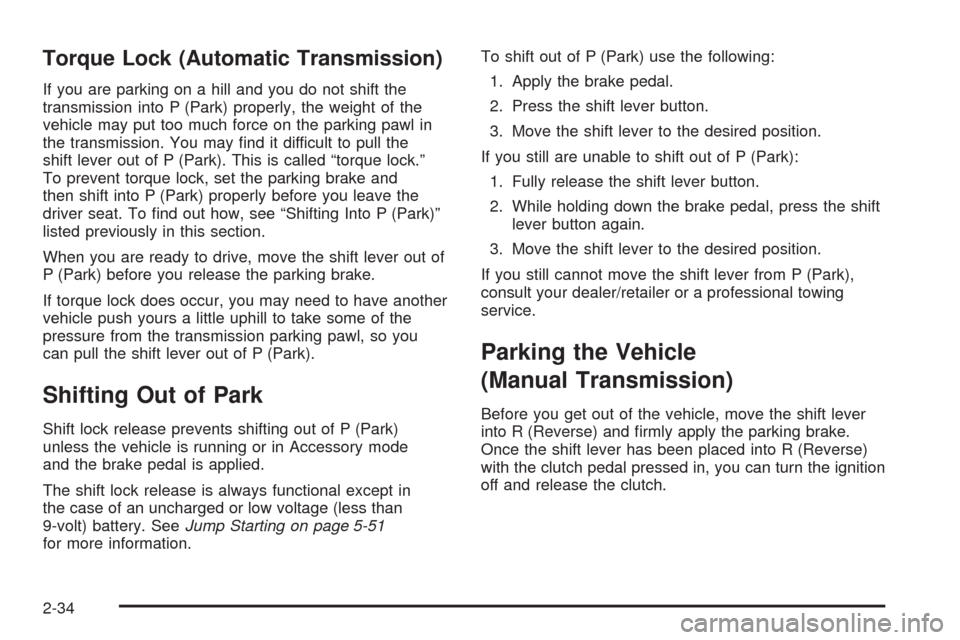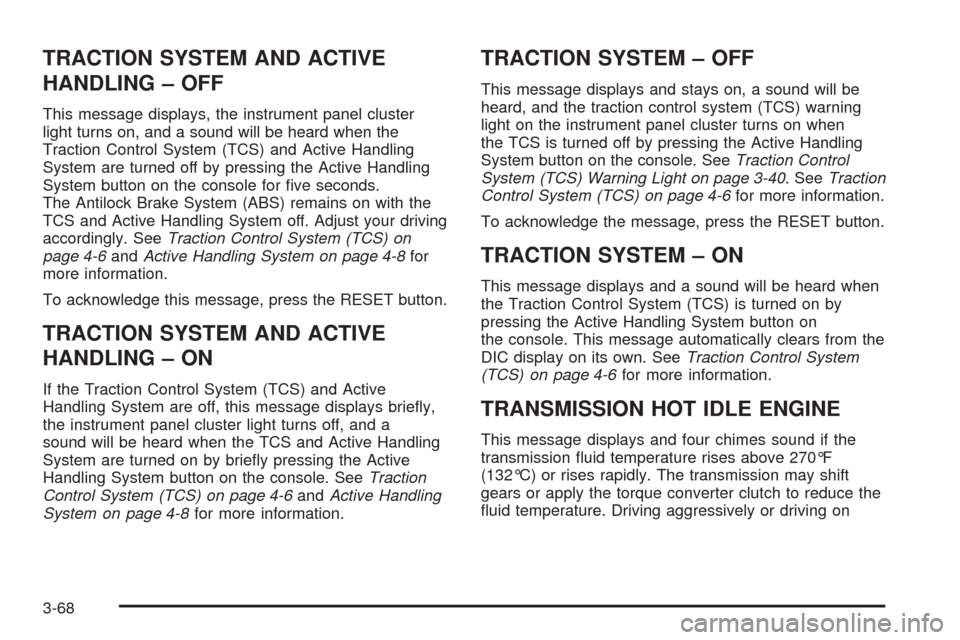Page 100 of 434

Torque Lock (Automatic Transmission)
If you are parking on a hill and you do not shift the
transmission into P (Park) properly, the weight of the
vehicle may put too much force on the parking pawl in
the transmission. You may �nd it difficult to pull the
shift lever out of P (Park). This is called “torque lock.”
To prevent torque lock, set the parking brake and
then shift into P (Park) properly before you leave the
driver seat. To �nd out how, see “Shifting Into P (Park)”
listed previously in this section.
When you are ready to drive, move the shift lever out of
P (Park) before you release the parking brake.
If torque lock does occur, you may need to have another
vehicle push yours a little uphill to take some of the
pressure from the transmission parking pawl, so you
can pull the shift lever out of P (Park).
Shifting Out of Park
Shift lock release prevents shifting out of P (Park)
unless the vehicle is running or in Accessory mode
and the brake pedal is applied.
The shift lock release is always functional except in
the case of an uncharged or low voltage (less than
9-volt) battery. SeeJump Starting on page 5-51
for more information.To shift out of P (Park) use the following:
1. Apply the brake pedal.
2. Press the shift lever button.
3. Move the shift lever to the desired position.
If you still are unable to shift out of P (Park):
1. Fully release the shift lever button.
2. While holding down the brake pedal, press the shift
lever button again.
3. Move the shift lever to the desired position.
If you still cannot move the shift lever from P (Park),
consult your dealer/retailer or a professional towing
service.
Parking the Vehicle
(Manual Transmission)
Before you get out of the vehicle, move the shift lever
into R (Reverse) and �rmly apply the parking brake.
Once the shift lever has been placed into R (Reverse)
with the clutch pedal pressed in, you can turn the ignition
off and release the clutch.
2-34
Page 204 of 434

TRACTION SYSTEM AND ACTIVE
HANDLING – OFF
This message displays, the instrument panel cluster
light turns on, and a sound will be heard when the
Traction Control System (TCS) and Active Handling
System are turned off by pressing the Active Handling
System button on the console for �ve seconds.
The Antilock Brake System (ABS) remains on with the
TCS and Active Handling System off. Adjust your driving
accordingly. SeeTraction Control System (TCS) on
page 4-6andActive Handling System on page 4-8for
more information.
To acknowledge this message, press the RESET button.
TRACTION SYSTEM AND ACTIVE
HANDLING – ON
If the Traction Control System (TCS) and Active
Handling System are off, this message displays brie�y,
the instrument panel cluster light turns off, and a
sound will be heard when the TCS and Active Handling
System are turned on by brie�y pressing the Active
Handling System button on the console. SeeTraction
Control System (TCS) on page 4-6andActive Handling
System on page 4-8for more information.
TRACTION SYSTEM – OFF
This message displays and stays on, a sound will be
heard, and the traction control system (TCS) warning
light on the instrument panel cluster turns on when
the TCS is turned off by pressing the Active Handling
System button on the console. SeeTraction Control
System (TCS) Warning Light on page 3-40. SeeTraction
Control System (TCS) on page 4-6for more information.
To acknowledge the message, press the RESET button.
TRACTION SYSTEM – ON
This message displays and a sound will be heard when
the Traction Control System (TCS) is turned on by
pressing the Active Handling System button on
the console. This message automatically clears from the
DIC display on its own. SeeTraction Control System
(TCS) on page 4-6for more information.
TRANSMISSION HOT IDLE ENGINE
This message displays and four chimes sound if the
transmission �uid temperature rises above 270°F
(132°C) or rises rapidly. The transmission may shift
gears or apply the torque converter clutch to reduce the
�uid temperature. Driving aggressively or driving on
3-68
Page 356 of 434
Tightening Wheel Lug Nuts
{CAUTION:
Never use oil or grease on studs or the threads
of the wheel nuts. If you do, the wheel nuts might
come loose and the wheel could fall off, causing
a crash.
{CAUTION:
Incorrect wheel nuts or improperly tightened wheel
nuts can cause the wheel to become loose and
even come off. This could lead to a crash. Be sure
to use the correct wheel nuts. If you have to replace
them, be sure to get new GM original equipment
wheel nuts.Notice:Improperly tightened wheel nuts can lead
to brake pulsation and rotor damage. To avoid
expensive brake repairs, evenly tighten the wheel
nuts in the proper sequence and to the proper
torque speci�cation.
Tighten the wheel lug nuts
�rmly in a crisscross
sequence as shown.
5-84
Page 383 of 434
ApplicationCapacities
English Metric
Transmission Fluid
Automatic Transmission (Pan Removal and Filter
Replacement)6.5 qt 6.2 L
Manual Transmission – Base 3.6 qt 3.5 L
Manual Transmission – Z51 4.2 qt 4.0 L
Manual Transmission – Z06 4.5 qt 4.3 L
Manual Transmission – ZR1 4.5 qt 4.3 L
Wheel Nut Torque 100 lb ft 140Y
All capacities are approximate. When adding, be sure to �ll to the approximate level, as recommended in this
manual. Recheck �uid level after �lling
5-111
Page 384 of 434
Engine Speci�cations
Engine VIN Code Transmission Spark Plug Gap Firing Order
6.2L LS3 V8 WAutomatic
Manual0.040 in (1.016 mm) 1–8–7–2–6–5–4–3
6.2L LS9 V8 R Manual 0.040 in (1.016 mm) 1–8–7–2–6–5–4–3
7.0L LS7 V8 E Manual 0.040 in (1.016 mm) 1–8–7–2–6–5–4–3
Engine Data
Engine Horsepower Torque Displacement Compression Ratio
6.2L LS3 V8 without
option NPP430 @ 5900 rpm 424 lb ft @ 4600 rpm 6.2L 10.69:1
6.2L LS3 V8 with
option NPP436 @ 5900 rpm 428 lb ft @ 4600 rpm 6.2L 10.69:1
6.2L LS9 V8
Supercharged638 @ 6500 rpm 604 lb ft @ 3800 rpm 6.2L 9.10:1
7.0L LS7 V8 505 @ 6300 rpm 470 lb ft @ 4800 rpm 7.0L 11.00:1
5-112